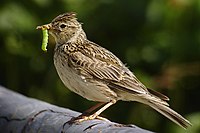
Photo from wikipedia
Abstract The lack of suitable nesting sites is one key driver behind the farmland bird crisis in Europe. Winter cereals become impenetrable for ground‐breeding birds like the Eurasian Skylark (Alauda… Click to show full abstract
Abstract The lack of suitable nesting sites is one key driver behind the farmland bird crisis in Europe. Winter cereals become impenetrable for ground‐breeding birds like the Eurasian Skylark (Alauda arvensis), curtailing breeding time. Stable Skylark populations depend on multiple breeding attempts per year; thus, the widespread cultivation of winter cereals has strongly contributed to their tremendous decline. Crop diversification is thought to be a potential measure to counteract this development. Therefore, we explored how individual Skylarks respond to the decreasing suitability of winter cereals as nesting habitats in heterogeneous but otherwise conventionally managed farmland. Our study focused on: (i) the degree to which Skylarks prematurely cease nesting activity, switch nesting habitats, or breed on linear structures like tramlines. Additionally, we analyzed: (ii) if nest success decreases throughout the breeding season and (iii) how often Skylarks make a successful breeding attempt per year. We radio‐tagged 28 adults in a German population during April 2018 and 2019, tracked half of them for more than 3 months, and measured their breeding success. Additionally, we monitored nests of untagged pairs, resulting in 96 nests found. None, except one tagged individual, stopped breeding activity before July 1st. Home ranges were mainly stable, but Skylarks switched nesting habitats away from winter cereals to crops like sugar beet or set‐aside. High‐risk nesting sites like corn and linear structures played a minor role in breeding. Overall, Mayfield logistic regressions revealed no seasonal decrease in nest success, and tagged Skylarks had sufficient time to make 1.5–1.8 breeding attempts, of which 0.8 were successful. We suggest that heterogeneous farmland in our study area, which enabled diversely composed home ranges, prevented a curtailment of the breeding season. Thus, our study reinforces the need for crop diversification which gives Skylarks a chance to survive in modern farmland.
Journal Title: Ecology and Evolution
Year Published: 2022
Link to full text (if available)
Share on Social Media: Sign Up to like & get
recommendations!